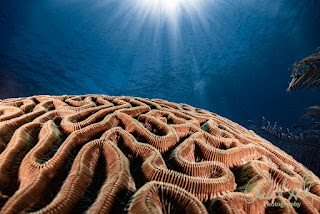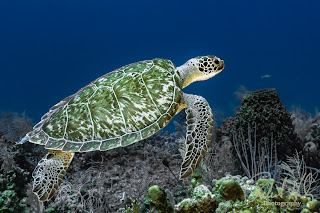Unleashing the Power of Tone Curves in Lightroom: Adding Drama to Underwater Photography
Capturing the beauty of underwater photography is just half the battle. The real magic often happens in post-processing, where we can enhance an image's depth, contrast, and overall drama. One of the most powerful tools available in Adobe Lightroom for achieving this is the Tone Curve. In this blog post, I’ll explore the Tone Curve, how to use it, and, most importantly, how it can take your underwater landscape shots from flat to fabulous.
What is the Tone Curve?
At its core, the Tone Curve is a graphical representation of an image’s tonal range. It lets you precisely manipulate the exposure, contrast, shadows, highlights, and midtones. The Tone Curve is broken into four main sections:
- Shadows (far left)
- Darks (just left of center)
- Lights (just right of center)
- Highlights (far right)
When you adjust the curve, you tell Lightroom how to handle different brightness areas in your photo. This tool's beauty lies in its flexibility and ability to target specific tonal regions. The RGB curve can also be broken into red, green, and blue channels, allowing for color adjustments that impact the overall mood of an image—perfect for underwater scenes.
Why the Tone Curve is Essential for Underwater Landscapes
Underwater landscapes often lack contrast and depth due to light absorption at different depths and water conditions. This results in images that may look flat or washed out. The Tone Curve allows you to:
- Boost contrast in specific areas (e.g., between foreground corals and background water)
- Enhance depth, making your photos appear more three-dimensional
- Add drama to scenes with sunbursts, open water, or even cave systems
By carefully manipulating the Tone Curve, you can control which areas of the photo stand out and which remain in shadow, guiding the viewer’s eye through the image.
How to Use the Tone Curve for Underwater Photography
Start Simple: Adjust the Contrast
Begin with the primary curve, often referred to as the linear curve. Create an "S" shape by slightly pulling the curve down in the Shadows and dark areas while lifting it in the Lights and Highlights. This adjustment increases contrast without losing too much detail.
Example:
Let’s say you’ve captured a vibrant coral reef, but the photo looks flat because the lighting conditions are cloudy. Adjusting the curve with an "S" shape will make the corals pop while keeping the water in the background soft but rich in color.Fine-Tune Specific Areas of Light and Shadow
If your photo has bright sunrays piercing through the water but the surface detail isn’t precise, consider pulling down the Highlights area of the Tone Curve. This will bring back detail in those bright areas while maintaining a high-contrast look.
Example:
Imagine you’ve taken a shot of a shipwreck in open water, but the sun's rays are overpowering the scene. By adjusting the Highlights, you can recover some of that lost detail in the sky or water surface while maintaining a dreamy, high-contrast effect in the darker parts of the image.Adding Depth with the Darks and Shadows
Underwater shots can sometimes look too evenly lit, creating a flat image. Push down the shadows and darks on the tone curve to create more dimension. This technique works well when shooting deep-sea scenes or when you want to emphasize the depth of a cavern or underwater landscape.
Example:
You’ve photographed a deep coral canyon, but the scene lacks that ominous, deep-water feel. Dragging down the Darks and Shadows will give the canyon the moody, dramatic look you're aiming for, as if the viewer could swim into the depths of the image.
Getting Creative with RGB Curves
Once comfortable with the standard Tone Curve, dive into the RGB channels. This is where you can manipulate the color tones and create specific moods in your underwater landscapes. For example:
- Red Curve: This adds warmth or cools down the overall scene. It helps adjust skin tones in divers or warm up coral reefs.
- Blue Curve: Great for making blue water stand out or adding a more ethereal feel to an open-water shot.
- Green Curve: Can be used to enhance or subdue the green hues of seagrasses or algae.
Example:
You’ve captured a photo of a diver surrounded by schools of fish, but the image feels too warm, with reds overpowering the natural blue tones of the water. By lowering the Red Curve, you can cool down the image and enhance the natural blue, giving the photo a more true-to-life underwater feel.
Before and After: Visualizing the Impact of Tone Curves
Let's see a practical example of how the Tone Curve can dramatically improve a typical underwater landscape shot.
Before Adjustment:
- The shot features a coral reef with a sandy bottom, but the colors feel muted, and the lighting is even throughout, making the image appear flat.
- The sun is peeking through the surface, but the highlights are too bright, losing detail.
After Adjustment with Tone Curves:
- Using the Tone Curve, you add contrast by pulling down the Shadows and lifting the Highlights slightly.
- You recover detail in the sunburst by adjusting the Highlights curve.
- By adjusting the RGB curve, you introduce more blue tones, giving the water a rich, vibrant look while keeping the reef warm and colorful.
- The final image has depth, the corals stand out, and the sunburst no longer overwhelms the scene.
Final Thoughts: Mastering the Tone Curve for Dramatic Underwater Images
The Tone Curve is one of the most powerful tools in Adobe Lightroom for transforming your underwater landscapes. With practice, it becomes an intuitive way to manipulate light, color, and contrast to create compelling, high-drama photos that capture the essence of your dive. Remember, subtle adjustments often yield the best results, so start small and build your way up as you explore the tool’s full potential.
Next time you edit a batch of underwater shots, try the Tone Curve and see how it can bring new life to your photos.
By mastering this tool, you’ll add another layer of post-processing skill to your underwater photography workflow, enhancing the technical quality and emotional impact of your images.
Stay Connected
Follow my blog for more tips and tutorials on underwater photography. Let's dive deeper into the art and craft of capturing the marine world!
Subscribe to my blog for more tips and tutorials on underwater photography. Don't forget to share your processed photos on social media using the hashtag #RobertHerbPhotography. I look forward to reviewing your results.
New Online Training Program
I am excited to announce that I am creating an online training program to teach underwater hobbyists and enthusiasts how to enhance their photos using Adobe Lightroom. If you are interested in this training or need more information, please go to (Underwater Photo Training) or contact me at bob@robertherb.com to express your interest and to be notified about the details and start date of the classes.
Stay tuned and "Follow" for upcoming blogs on underwater photography tips and tricks for more in-depth insights. Please leave your comments and suggestions. Enjoy your diving and shooting experience!
I am eagerly anticipating your valuable feedback and suggestions.
Sincerely,
Bob Herb
|
|





Comments
Post a Comment
Please let me know your comments.